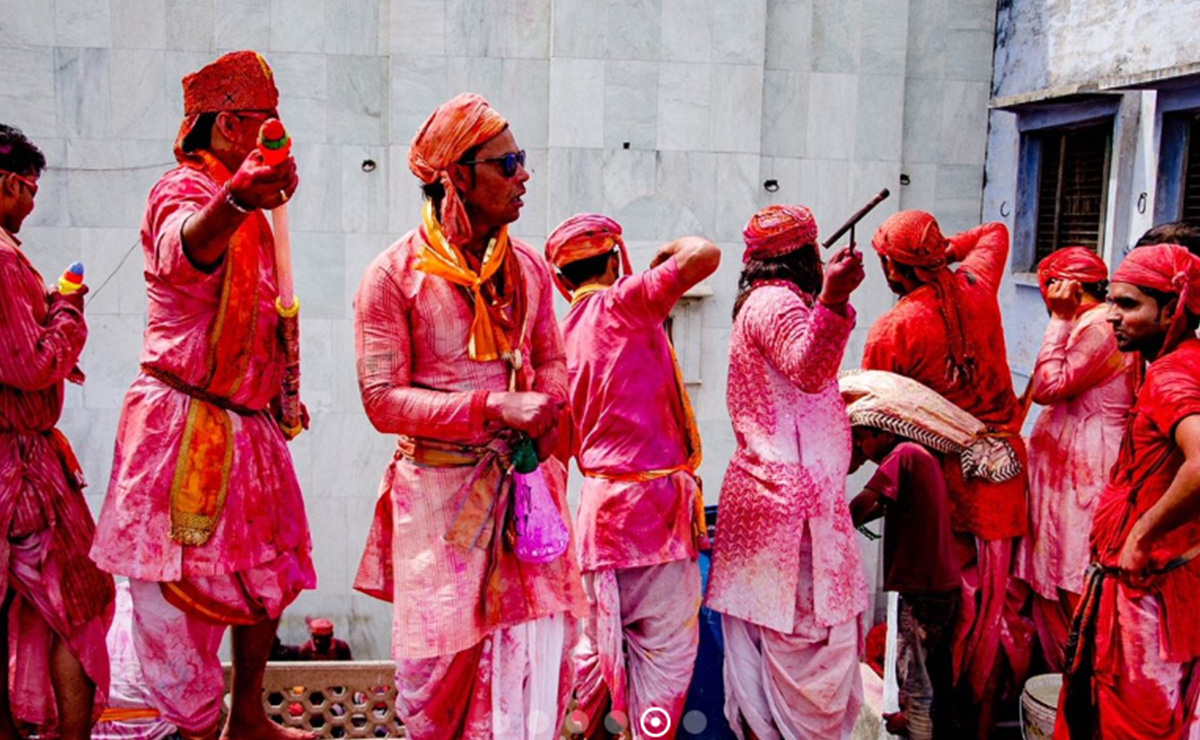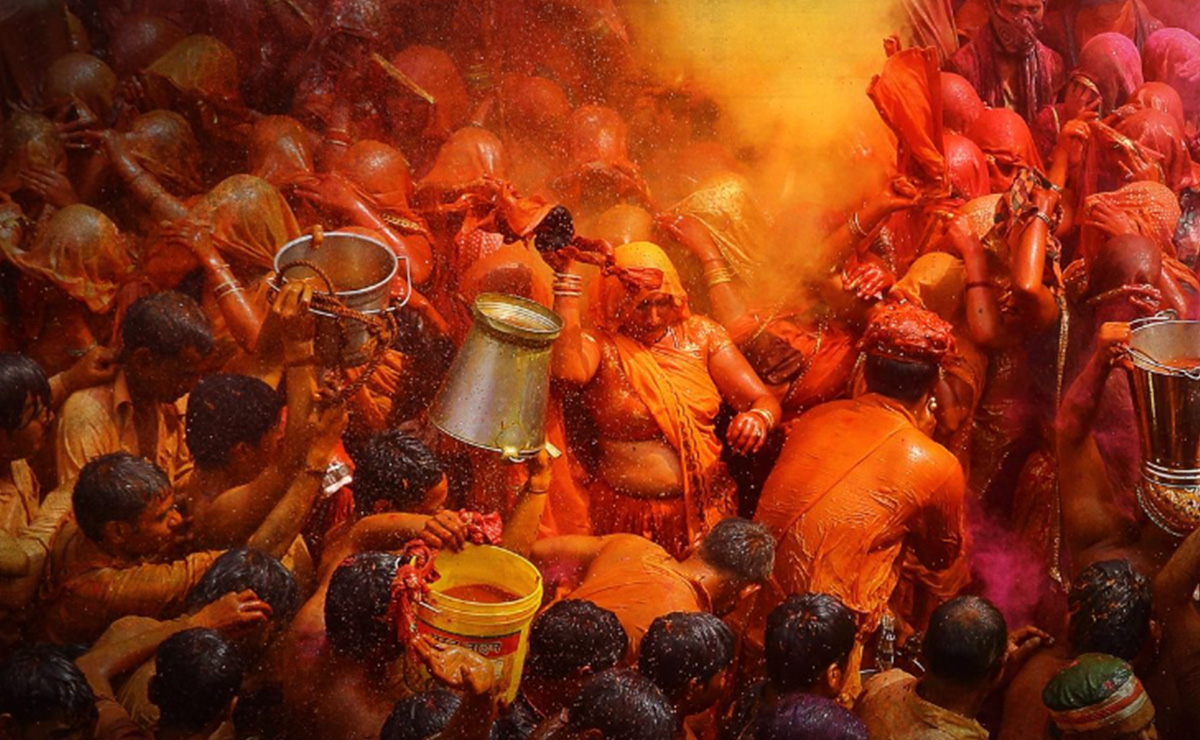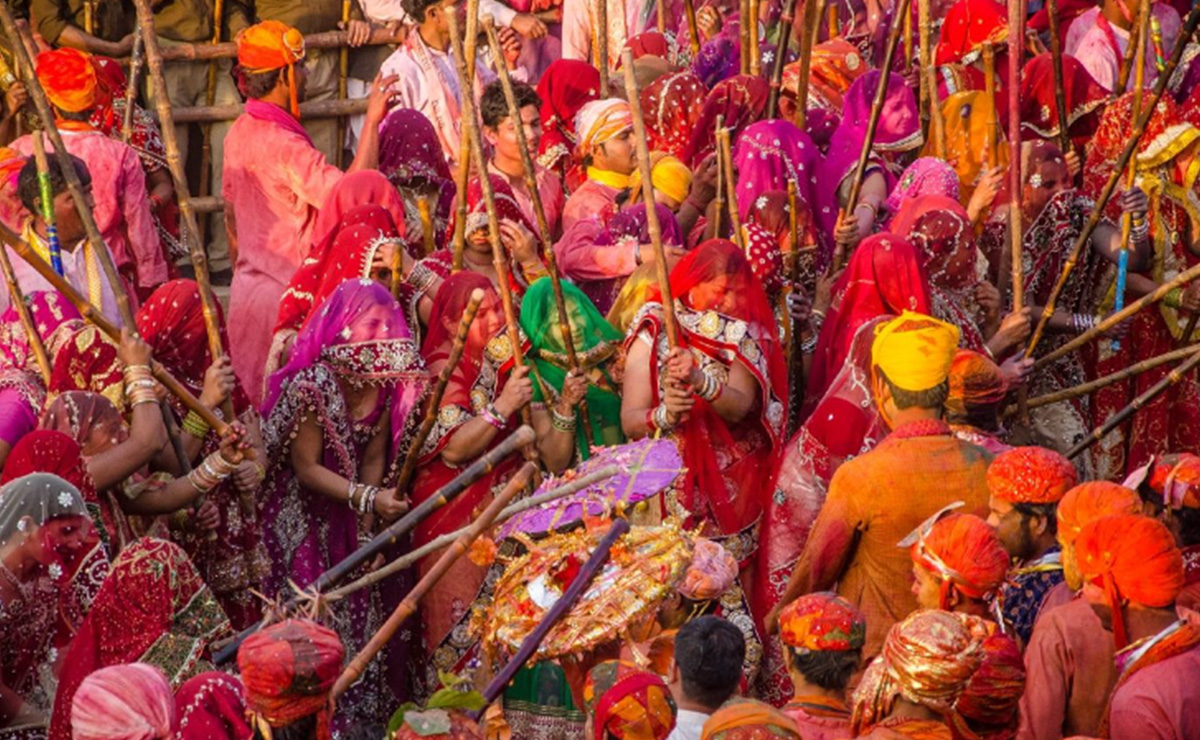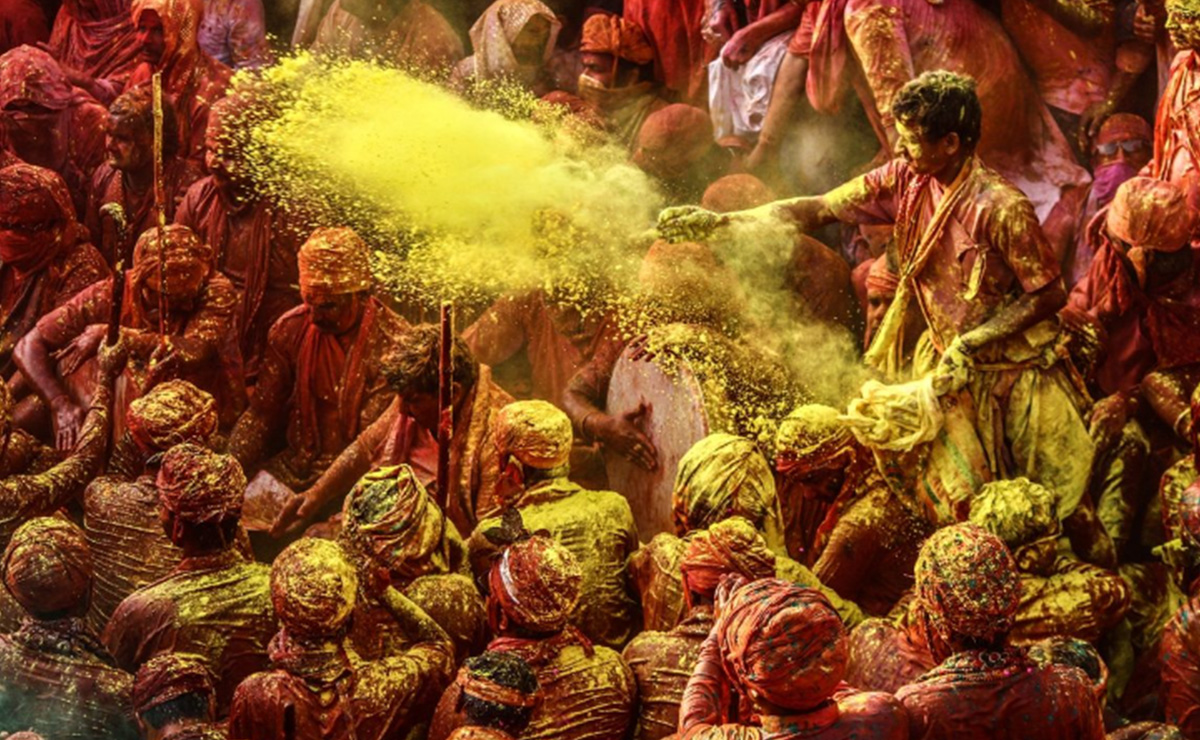WHY TRAVEL WITH US
festival of colours
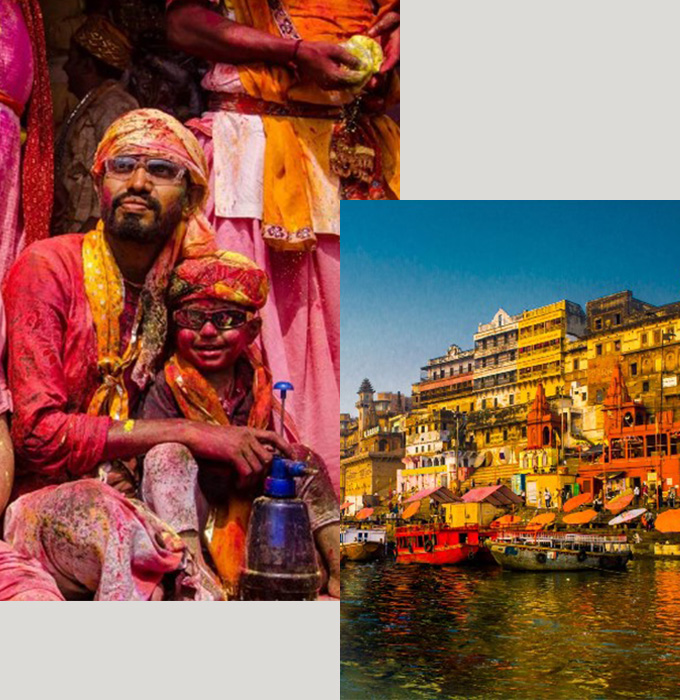
FESTIVAL OF COLOURS
On a pleasant evening of early March, in a small bylane leading towards Dashashwamedh Ghat, the main and probably the most spectacular ghat in Varanasi on the Ganga River, an energetic young folk singer stood up from the crowd of saffron-clad pilgrims to a make-shift Dias and started singing the following lines: “You can even hide your thoughts from yourself / But how can you hide it from Bhole Baba? So, speak out.” The bustling crowd joined spontaneously: HOLI HAI! (It is Holi).
Holi is a Hindu festival celebrating the end of winter and thus the arrival of spring. This Indian festival takes place over 2 days: on the first evening, fires are lit in memory of the cremation of the demon Holika, representing evil, defeated by Vishnu. On the second day, there are large festive gatherings in the streets. People come together regardless of castes, throw colours while dancing. Though Holi Festival is celebrated throughout India, it is more colourful in the North. It is very much like the European carnivals.
Your journey will start from Delhi, your first rendezvous with the subcontinent called Incredible India! You will discover the soul of the Old Delhi hidden behind the chaotic bylanes and bazaars at the foot of the Jama Masjid before drifting to the grandeur of the majestic colonial buildings of Lutyens New Delhi. The next day, you will be airlifted to Varanasi, the Mecca of Hindu religion is situated on the right bank of the sacred river Ganges revered by the local people as “Gangaji. Here you will savour the taste of mysticism at the evening Aarti ceremony celebrating divine life not very far away from the cremation ground of Manikarnika at the backdrop of 500 Hindu temples.
Next day, you will be again airlifted from the holy city of Varanasi to Jaipur, the mountainous terrain of the Maharajas and Maharanis where you will be given a royal welcome. Here, a walk around the colourful markets of the Pink City will show the preparation of the coming festival. You will be forced to ask a thousand questions to your guide: why people are buying garlands made of cow dung cakes, why the market is flooded with so many colour powders, why the ladies are putting Mehendi on their hands etc, etc, etc. Unperturbed by the movement of a decorated elephant passing by his side, your guide will share his knowledge of the festival with you here, in Jaipur.
On your way to the most famous city of Holi celebration of India – Mathura, your next destination is Agra, 36 km away from Fatehpur Sikri. The architectural marvel in red sandstone, the palace of Emperor Akbar in Fatehpur Sikri, is a world heritage monument. In Agra, your guide will accompany you inside the Taj complex and by making you stand in front of the Taj Mahal, he will simply tell you: “This monument needs no explications. She speaks herself. ” Obeying your guide and mesmerized completely by the purity of the white marble, you will join the huge Indian crowd who are here on their way to Krishna’s land Mathura. You will even be forced to notice that engrossed in their dream of Holi in Vrindavan, the crowd is simply making a ritualistic parikrama of Taj mahal without properly looking at it.
On 24 March you will arrive at your final destination by traveling 60 km from Agra by Yamuna Expressway to the Holy city of Mathura. Here standing next to the only surviving tower of the astronomical observatory built by the Maharaja of Jaipur in the 18h century, you will look at the water of the sacred Yamuna River and then turn your head towards the Dwarkadhish Temple where the statue of Lord Krishna reflects the colour of the river. This will be your initiation to Krishna consciousness.
The 25 March is Holi. This day is dedicated to experiencing the Festival of colours. As a tourist, you can decide whether or not to take part in this festival. The locals will be happy to integrate you and throw all kinds of pigmented powders on each other. You can dance, have fun and feel like a local. However, if you don’t want to take part physically in the festivity, that won’t be a problem. The Indians will understand and, as long as mutual respect remains, you will not be annoyed.
After the day-long experience of Holi in Mathura which is a dream for many people, you will begin your return journey the next morning. On reaching Delhi, you will explore a few sites, which were not included on the first visit. Then late night we will provide departure transfer to Delhi airport to board the flight back home.
Highlights
- Take a walk through the ancient streets of Old Delhi
- Be a part of spiritual celebration, Aarti, at Varanasi
- Roam in the pink city, visiting royal City Palace & Amber Fort
- Visit the marvelous piece of Mughal architecture, Taj Mahal
- Immerse into Holi festival and celebrate like a local
- Explore the colourful side of India with a personal guide
Day 01 - Arrive Delhi
After completing the immigration and customs, proceed towards the arrival hall at the airport, where you will be welcomed by our representative and transfer to the hotel. Delhi, the capital of the largest democracy of the world, can’t be defined in just one single sentence. The city has been plundered, destructed, reconstructed and ruled over by several dynasties. Having its existence for centuries, today the city stands as a metropolitan city and a center of business sector. However, even after being a city of skyscrapers and modern lifestyle, the city has kept its ancient heritage alive even today.
Overnight in Delhi
Day 2 - In Delhi
Breakfast at the hotel. After breakfast, proceed for the sightseeing of Old Delhi which includes a visit to the Red Fort (closed on Monday), built-in 1648 during the reign of Shah Jehan in red sandstone, which gave the fort its name. One of the largest mosques in the country, Jama Masjid was built around the 17th century by Shah Jehan. The mosque is constructed in red sandstone and white marble. Chandni Chowk is one of the liveliest places in Old Delhi which happened to be the imperial avenue where Emperor Shah Jehan rode at the head of the royal parade. Now, Chandni Chowk is full of shops, ateliers and stalls.
***The markets of Old Delhi are closed on Sunday.
After this, we will head to New Delhi to visit India Gate which was built as a war memorial for the soldiers who were killed during WW I. Next, we will visit Rashtrapati Bhawan, the Viceroy’s imperial residence which was built in the 20th century. Today, it is used as Parliament and official residence of President of India. After exploring this royal building, we will explore the first Mughal garden tomb, Humayun’s Tomb built in the 20th century. The emperor’s senior widow and mother of Akbar, Hamida Begum built this tomb. We will finish our day after visiting Qutub Minar, the 70 meter high minaret standing majestically since 1311AD.
Overnight in Delhi
Day 03 - Delhi – Varanasi by Flight
After breakfast transfer to the airport to board flight to Varanasi. Arrive Varanasi, assistance on arrival and transfert o hotel. One of the oldest cities to exist today, Varanasi has a history which is more than 3000 years old. Every step you take here, you will find Hindu temples. If scriptures are to be believed, one who takes the last breath in this spiritual city, get free from the circle of births and rebirths and attains nirvana. The afternoon is relaxing. In the evening, we will visit the banks of the Ganges River where the Aarti ceremony is carried out and attend it. You will sense a remarkable sensory experience when you will see countless number of earthen lamps which shower yellow light on the riverside in the evening. Varanasi city comes to a halt. The enchanting sound of bells and chimes fill every street with spirituality.
Overnight in Varanasi
Day 04 - In Varanasi
Early sunrise boat ride over the Ganges River. Ganga Ghats are adorned with temples or more than a hundred ghats which are located alongside the river. Therefore, the most suitable way to visit and cover every ghat is through boat ride. The boat ride will give you a scenic glimpse of all the ghats which are drenched in crimson light. Return to the hotel.
After breakfast, we will do a sightseeing tour of Varanasi city and will visit Durga Temple. Built in the 18th century, this famous temple is dedicated to Hindu Goddess Durga. We will also cover Tulsi Manas Temple, “Bharat Mata” (Mother India).
Excursion to Sarnath (10 km/about 25 minutes’ drive one way), where Buddha delivered his first sermon (religious language). Here, we will visit the Sarnath Museum (The museum remains closed on Friday). Later, we will visit the Mulagandha Kuti Vihar Temple which is beautifully decorated with frescoes which highlight the life of Buddha.
Overnight in Varanasi
Day 05 - Varanasi to Jaipur by Flight
Breakfast at the hotel. This morning, we will take you on a walk of the city – this will give an insight into the way people live in their real life. Later transfer to the airport for your flight to Jaipur.On arrival at Jaipur airport, you will be assisted in the hotel.
The state capital of Rajasthan, Jaipur is also called Pink City. Laid out according to the ancient symbolic plans as a walled city in the 18th century by Maharaja Jai Singh, the city represents its architectural splendor as well as an exceptional harmony. The City Palace serves as the heart of Jaipur city. The palace is enclosed by broad tree-lined avenues. The city has been divided, by these avenues, into traditional quarters which are assigned to different occupations.
Overnight in Jaipur
Day 06 - In Jaipur
After breakfast drive to the nearby 16th-century hilltop fortress of Amber, ascending the tortuous paved pathway to the fort in jeep. Maharaja Man Singh started with constructed work of this medieval Rajput capital which has many palaces. Later, Rajputs used it as their stronghold. The capital was then moved to the newly built Jaipur when Sawai Jai Singh II became king. In the afternoon, we visit City Palace; still occupied by Jai Singh’s descendants which is a superb fusion of Rajput and Mughal architecture. A city within a city, it includes the Govind Deo Temple; the Jantar Mantar (observatory); on the periphery of the Palace stands Hawa Mahal (the Palace of Winds): an elaborate pink sandstone façade, behind which the ladies of the court sat and watched the daily goings-on in the street below. Evening, we will take you to a Hindu Temple to experience the aarti ceremony. There is daily Aarti (prayer) at different times during the day. Evening aarti is something interesting to watch.
Overnight in Jaipur
Day 07 - Jaipur to Agra by drive 265 km about 6 hrs
Breakfast at the hotel. After breakfast drive to Agra with a stop en route at Fatehpur Sikri – visit the deserted sandstone city & capital of Emperor Akbar. Continue to Agra after the visit of the deserted city. During Mughal Era, Agra was named Akbarabad. The city houses some of the most incredible monuments belonging to the Mughal dynasty. One of such monuments is the Taj Mahal which is world-famous for its architectural beauty and has left an impression on the entire world. Taj Mahal is located on the banks of Yamuna River. Agra which is the 3rd largest city of Uttar Pradesh has 4 UNESCO World Heritage Sites. Late afternoon visit Mehtab Bagh during sunset for a mesmerizing view of the Taj Mahal on the other side.
*** Taj Mahal closed on Every Friday
Overnight in Agra
Day 08 - In Agra
After breakfast, city sightseeing the world-famous Taj Mahal, set within the paradise gardens. The whole of the Taj complex measures 580 by 300 m and the garden 300 by 300 m. The guiding principle is one of symmetry. The four minarets (41.6 m high) at each corner of the plinth provide balance to the tomb. Agra Fort – on the west end of the Yamuna River, Akbar’s magnificent fort dominates the centre of the city. The outer moat is towered over by the outer walls with red sandstone which are 20 meters in height. Itmad-ud-Daulah – If legends are to be believed, the inspiration behind the construction of Taj Mahal was taken from the Tomb of Itmad-ud-Daulah and thus, the tomb is also referred to as ‘Baby Taj’. This beautiful marble mausoleum is worth a visit.
Overnight in Agra
Day 09 - Agra to Mathura by drive 60 km about 1.5 hrs
After breakfast, drive to Mathura to experience the Festival of Colours. Mathura is situated about 60 km from Agra on the Delhi-Agra road, on the right bank of the Yamuna River. It is a great center of Hindu pilgrimage, being regarded as the birthplace of Lord Krishna. Mathura has several temples dedicated to this deity, of which the most outstanding are the Dwarkadhish shrine in the crowded marketplace, the temple at the birthplace of Lord Krishna and Gita Mandir on the way to Vrindavan, where Krishna grazed his cattle during his childhood. We explore the Temple complexes of Mathura.
In the evening, we will be witnessing the PRE HOLI CELEBRATIONS.
Overnight in Mathura
Day 10 - In Mathura
This day is dedicated to experience the Festival of Colors – Holi (the festival of colors) is played with lots of religious values in Mathura and Vrindavan and is dedicated to Lord Krishna.
Overnight in Mathura
Day 11 - Mathura – Delhi by drive 190 km about 5 hrs
After breakfast, drive to Delhi. This day the group is free to relax.
Overnight in Delhi
Day 12 - Depart Delhi
This day, we will explore a few sites which were not included on the first visit – Birla Temple, Gurdwara, market and others.
ROOM TILL 2100 HRS
Late night departure transfers to Delhi airport to board the flight back home.

